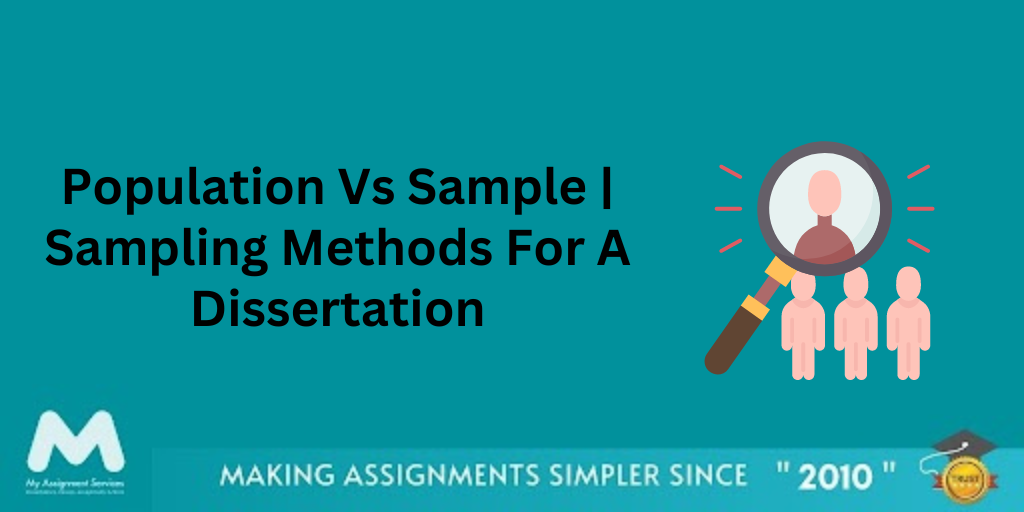
In statistical analysis of population vs sample, the quality of the result hinges on the integrity of the data. The data employed must be appropriate and representative of all pertinent categories. Therefore, while gathering more data improves the impartiality of outcomes, it is imperative to ensure that the data collected is relevant to the particular issue being addressed. However, one of the effective ways to ascertain this relevance is learning and understanding the distinction between population and sample.
This tutorial will equip you with a comprehensive learning and understanding of sample vs population in dissertation. Furthermore, the population donates the entirety of individuals under consideration for conclusion. Conversely, a sample refers to the subset of individuals from which data will be gathered in one place. Moving forward, in this web blog, we will not only study the key differences between population and sample but also look into the effective ways of collecting data in population and sample. So, read this write-up till the end to get precise knowledge.
Population encompasses the complete set of individuals or items that pique a student’s interest in the study. However, it might encompass people, plants, animals, objects or any other grouping. For example, if a student aims to investigate the dietary patterns of all adults within a particular country, the population would consist of all adults residing in that country. Let’s continue with population vs sample and its effective ways to collect data.
Gathering data from a whole population can be difficult, especially if the population is large or geographically dispersed. However, there are several approaches students can use to collect data from a population:
Using existing administrative databases or records maintained by government agencies, institutions or organisations. These records often contain valuable information about individuals or items within a population. Therefore, it includes census data, healthcare records, text records or educational records.
In between sample vs population in dissertation, surveys involve administering interviews or questionnaires to a representative of a population sample. Likewise, while surveys are often used for sampling, they can also be employed to gather appropriate data from the entire population if feasible. However, this method allows students to gather information directly from individuals. Similarly, it provides insights into their opinions, behaviours and characteristics.
Observing and recording information about individuals or items within the population firsthand is the common method in anthropology, sociology, and ecology, where students observe natural behaviours in their environment.
In the section on population vs sample, use remote sensing technologies such as drones, sensors, or satellites to gather data about environmental features of phenomena within a population. Therefore, remote sensing is specifically useful for studying huge geographical areas or inaccessible locations.
Analysing data generated from social media platforms, online communities or websites to comprehend the behaviours, interactions and preferences of individuals within the population can provide useful insights into digital populations and online communities.
The physical measurement method involves taking physical samples or measurements from individuals or items within the population. Moreover, it is commonly used in biology, engineering, and medicine to collect purpose physiological characteristics or properties data.
While studying sample vs. population in dissertation, you will learn about the vital section of the population that is ethnographic research. Hence, ethnographic research involves immersing oneself in the culture or community of interest to understand the population’s beliefs, social dynamics, and practices deeply. It often involves much longer participant observation and engagement.
A sample is a subset of items, observations or items selected from a wide group or population to represent the characteristics of that huge group. In other words, it is a smaller, manageable portion of a population study to make inferences about the entire population.

The sampling process comprises numerous imperative steps to ensure the representativeness of the selected sample about the population and the reliability of the gathered data. Moving forward, here we have outlined the crucial steps in the sampling process so that you will be able to understand the key steps and complete your dissertation like a professional academic writer who provides top-notch dissertation writing services.
Straightforwardly define the population of interest that the research aims to study. Nevertheless, this could be a particular group of people, items, or observations with common features.
Recognised the list or source from which the sample will be drawn. Furthermore, the sampling frame should include all components of the population and should be accessible for sampling.
Select an appropriate sampling method based on the research objectives, population characteristics, and available resources. Likewise, typical sampling methods encompass random, cluster sampling, stratified and convenience sampling.
In population vs sample, determining sample size is the best way to get an accurate sample size per the requirement to achieve the desired level of confidence and precision for the study. Sample size calculations often consider components such as the population size, desired margin of error and variability.
Select the sample from the sampling frame using the chosen sampling method. Furthermore, make sure that the sampling method is randomly selected or systematic to minimise bias and make sure representativeness.
If the research involves human subjects, obtain informed consent from participants before gathering accurate data. Inform participants about the objective of the study, their rights, and any benefits or potential risks involved.
Once the sample is selected while studying briefly about sample vs. population in dissertation, gather data from the sampled individuals, observations, or items using accurate data collection techniques such as interviews, measurements, surveys, or observations.
Study the collected data using suitable statistical methods and techniques. Therefore, ensure the analysis accounts for any sampling design or weighting components to obtain appropriate estimates and make valid inferences about the population.
Data are alphanumeric representations of statistical data variables, both qualitative and quantitative. Moreover, the data are those components that allow statistical inference to be made to know the actual causes and make the predictions. With the appropriate statistical data, the major differences we will explain to you are closely related: Population vs sample.
|
Aspect |
Population |
Sample |
|
Definition |
The research strives to study the entire group of individuals, items, or adherence. |
A subset of individuals, items, or observations selected from the population for study. |
|
Size |
Typically larger, comprising all elements of interest within a defined group. |
Smaller, illustrating a part of the population. |
|
Representation |
Consists of every member or element of the group. |
It represents a proportion or subset of the population. |
|
Scope |
The target of generalisation in research is where conclusions are drawn. |
Used to make inferences about the larger population. |
|
Data Collection |
It may involve various methods depending on the research goals and resources available. |
It is typically collected through sampling methods such as random sampling, stratified sampling, or convenience sampling. |
|
Analysis |
The analysis is a crucial step that aims to deeply understand the group's characteristics, trends, and patterns, providing valuable insights for further research. |
The analysis focuses on making inferences about the population based on the characteristics of the sample. |
If you are stuck with your dissertation on differences between sample and population, look no further than My Assignment Services. Our commendable team of 2500+ academic writers are here to provide you with the best dissertation writing services that will lead to your desired grades in finals. However, like any other professional assignment service provider, our goal is not only to provide you with your coursework while considering all the college parameters.
Therefore, our primary goal is to transfer precise knowledge of the subject matter to students through our 1-1 live sessions. It is the best way to clear the minor doubts that you ignore while studying and end up getting stuck on that particular topic. Well! If you have the capability to write your dissertation without any help, then our feedback services are the perfect match for you. Our academic experts have keen eyes that detect last-minute mistakes that your eyes might ignore in seconds. So, it’s time to transfer your academic stress to us! Call us today to enjoy our top-notch services at very competitive rates. To know more, visit our official website.

Hi, my name is Dr. Alice Campbell and I hold a Ph.D. in Literature. I primarily guide students through the dissertation process and provide a deeper understanding of research methodologies and literary analysis. I work as an academic writer for Online Assignment Expert while lending my expertise to assist students in writing dissertation assignments.
1,212,718Orders
4.9/5Rating
5,063Experts
Turnitin Report
$10.00Proofreading and Editing
$9.00Per PageConsultation with Expert
$35.00Per HourLive Session 1-on-1
$40.00Per 30 min.Quality Check
$25.00Total
FreeGet
500 Words Free
on your assignment today
Trending now
The Student Corner
Subscribe to get updates, offers and assignment tips right in your inbox.
Popular Posts
Popular Posts
Request Callback
Doing your Assignment with our resources is simple, take Expert assistance to ensure HD Grades. Here you Go....
Lock in your expert now.
Pay the rest only after you're 100% satisfied.
Why this is a no-brainer:
Loved reading this Blog? Share your valuable thoughts in the comment section.
Add comment